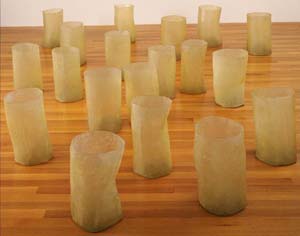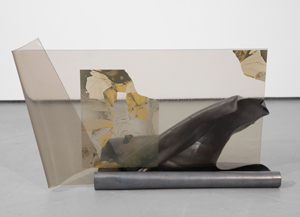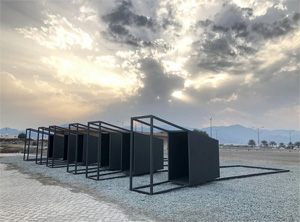Expanding Minimalism
John Haberin New York City
Eva Hesse: Expanded Expansion
Charisse Pearlina Weston, Xaviera Simmons, and Torkwase Dyson
"What I want of my art I can eventually find. The work must go beyond that."
Count on Eva Hesse for confidence in what she could do. Count on her, too, to demand still more of herself and her art. Not that it was an undue burden, she felt, no more than other typed notes to herself. She need only let the work take care of itself. It led her to the twofold excess of Expanded Expansion, in the Guggenheim collection. It comes back on view after restoration for the first time in thirty-five years. 
Richard Serra, too, was never one to go with the flow. At least you better hope so, lest one of his rusted steel walls tumbles down on you. For both, Minimalism was about the power of objects—the power to speak for themselves, for the space around them, for the gallery, and for you. As Hesse herself transformed it, it grew also to speak for a woman. It seems to bear her bodily sensation as well. Can it still today?
At the Queens Museum, two objects suffice to speak for African Americans about the history that often excluded them. That just happens to include the history of the museum. Charisse Pearlina Weston sees a defining moment in the museum's origins, as a pavilion at the 1964 World's Fair, and yet she cannot stop speaking herself of its exclusions. Xaviera Simmons hears instead a moving cacophony. Will you see the politics of race and art in a gray plane and a big black box? In the galleries, in turn, Torkwase Dyson offers a correction with her own walls, as "A Liquid Belonging."
Keep expanding
Expanded Expansion keeps expanding, to command an entire wall in a tower gallery, twenty-five feet across and more than ten feet high. It expands beyond the very idea of restoration at that, for this is by no means what Eva Hesse wanted or saw, just as she asked. She left it in a state of deterioration and discoloration from day one. She poured latex onto cheesecloth suspended between yellowing fiberglass and polyester poles. Its thirteen segments run the gamut of reddish yellow, like cells in a color chart, only to pause for a deep reddish brown, as if to disrupt expectations of rigor or subtlety in art. If latex is a natural rubber, found in plants, deterioration is the state of nature as well.
It should make anyone uncomfortable, like all her work, in its material presence and decay. It has a discomforting status, too, between hard and soft materials—and between sculpture and surrounding space. She worked with Minimalism, with its simple shapes and industrial materials in series, while rejecting its clean edges and firm geometry. A 2006 Eva Hesse retrospective at the Jewish Museum and the Drawing Center showed her creating a Post-Minimalism, along with such peers as Susan Rothenberg. (Allow me not to repeat my review back then, so by all means follow the links for more.) It has new relevance as well with a kind of Neo-Minimalism in art today, on view in a concurrent show at the Guggenheim of recent acquisitions—and now with Weston and Simmons.
It has added relevance, too, up the ramp from a show about collecting abstraction—and amid contemporary art about gender. It puts a woman's body under a woman's control while rendering it all the more discomforting, both for herself and for men. Yet her boundless confidence found its limits all the same. She completed Expanded Expansion in 1969, a year before her death of brain cancer at just thirty-four. Her family had fled Nazi Germany, and she divorced Tom Doyle, also a sculptor, in 1966. She was starting over on her own, on a new life, but second and third chances were running out.
It is still not easy to see beyond the discomfort, but the Guggenheim does its best. It stresses her support from others in Minimalism like Sol LeWitt. She exhibited with top artists in midtown—and surely no one better fit a group show of "Eccentric Abstraction." A patron drew Hesse and Doyle back to Germany with a free studio. Just as much, one can see the work as not just bodily decay, but an experiment. Latex was itself a scientific experiment, a milky liquid that hardens in air into India rubber, and she took time off to observe the experimenters.
The show includes interviews, sketches, and fragments of her materials. Are they studies or independent works? Either way, they are further experiments. She called them Test Pressings, layered like carpet samples or molded into irregular, often grisly shapes. In line with her confidence and sense of humor, they appear in a pastry case. They do not look edible.
Whatever her disappointments, Expanded Expansion expanded on an ambitious career. Hesse had never worked on half that scale, and it allowed her old concerns an independent life. She was still working in ambiguous materials, held together by their own weight. Yet one cannot conceivably mistake them for human flesh. The supports leaning up against the wall might be flagpoles, and the folds between them might be draperies, but formidable and stiff. They hide nothing but themselves.
Objects speak of black
Out in Queens, the objects themselves are black. For Charisse Pearlina Weston, make that shades of gray, responding to light and darkening the room. She suspends a large translucent plane from overhead, holding one at a distance while welcoming one beneath. She thought of Richard Serra— although its curtained space may bring her closer to Kapwani Kiwanga at the New Museum. Serra's rusted steel walls enfold but also seemingly bar entry. Her plane, too, hides nothing, even as it casts its shadow.
although its curtained space may bring her closer to Kapwani Kiwanga at the New Museum. Serra's rusted steel walls enfold but also seemingly bar entry. Her plane, too, hides nothing, even as it casts its shadow.
Other translucent objects rest on pedestals, like proper fine art, in rolled lead and pale yellow prints on glass. Yet they and their voices are already crushed. Had she stopped there, she would have a suggestive exhibition. Its title alone is a poetic mouthful, of [a] tomorrow: lighter than air, stronger than whiskey, cheaper than dust, from an 1875 ad for barbed wire. But there is more to come. The 1964 World's Fair, she has argued, set out to exclude people, black people, and she wants to offer resistance even now, much as the Congress of Racial Equality (CORE) back then called for a mass protest to shut it down.
Can we really afford, a guard asked, a world's fair when people are dying—but really how can we not? It takes extravagance to encourage inclusions rather than racism and international cooperation rather than the arms trade. A museum like this one fosters diversity and community with its artists and audiences. Many come to see its model of New York left over from the 1964 World's Fair and recognize it as theirs. Without art and culture, Weston and the guard would be out of a job, and I would be out of hope. I would also be out of the chance to see the dark, soaring translucency of her work.
Xaviera Simmons starts with a sterner view of Minimalism. Her rectangular mass might have landed in the museum's atrium from the studio of Donald Judd, were it not mammoth, black, and covered on three sides with hand-lettering in white. Think of a rewrite of African American history after James Joyce. It is all ours, bit its unnamed we may at a given moment be black, white, or both. Neither so much as existed, it cries, until Europe brought Africans and slavery to America. All caps amounts to shouting, but it has every right to shout.
It need not break the silence. Simmons has graced more than a few group shows with formidable architecture, but also spare prints. Her black block is no more a barrier than her wrought-iron fence packed with text among 2020 New York summer sculpture. Then she surrounds it with large color photos, and its fourth side opens onto an interior. There its light boxes may look out or in. Their landscapes are devoid of human life, but rich in something besieged by humanity.
The bodies in photos press between fabric and wallpaper. The archival image of a peanut factory and worse hides them all the more. Enlarged Polaroids pair ocean waves with pottery. They assimilate nature to the broken promises of history. Is either artist too explicit or not halfway explicit enough? Relish the silence.
Go with the flow
Torkwase Dyson brings the viewer close—to engage the work, its mass, and the space of the gallery. She counts steel among her materials, and one could mistake everything she touches for it. Yet her walls have none of rust's warmth nor its overtones of destruction and decay. Her Symbolic Geography sticks to black, to insist on the place of blackness in American art and history. If Richard Serra were not imposing enough, African Americans like her, she asserts, are just not going away. The symbolism may be arbitrary and invisible, but she has a point. 
She makes the point with a traditional notion of art, for all its Minimalism. It is an art object, not the defiance of geometry in Serra's own black art, shreds of vulcanized rubber covering the floor. It suits an upscale dealer well. How many can afford a custom-made building to themselves, like Pace gallery, opened just in time for the Covid-19 lockdown? Dyson makes good use of its windowed seventh floor, with its drama and a view. Her slab nestles neatly into its broad steps at one end and over the top of a wall at the other—not a threat or an obstacle, but an invitation to pass beneath.
She makes a point, too, of the artistry in its making. Her materials are glass and wood, her blackness acrylic, graphite, and ink. Works downstairs do use steel, piercing her hinged walls and outlining competing slabs in space. Where Serra's steel curves throw their weight around, Dyson uses her walls as anchors so that the steel frames can ascend—in one case, starting just off the floor. In her hands painting, too, can be a wall. At the very least, it can represent one, like a New York street for Edward Hopper, East Village brick for Martin Wong, or a Detroit factory for Charles Sheeler.
Her work bows to tradition, too, in its relationship to the viewer. Like Serra, she depends on the play between distance and intimacy, but there is no entering the work to feel its demands. One can only look. The seventh floor has her Beloved Stillness (Hypershape), the paintings her Blue Belonging. In practice, a piece of wood or a white line interrupts the blackness. But then belonging sings the blues of America in black and white.
The flow kicks in up close, where sculpture is no longer a monolith. Black liquid pools on its surface, seemingly still flowing. True, Serra flung molten lead in performance, but in no particular direction. It also kept others at a safe distance. For Dyson, sculpture has much the same texture as her painting, as a mark of its making. She can hedge on whether to call it hyperspace or stillness.
She can overwhelm you even as she lures you in, but she has first to overwhelm herself. She wants to look past herself, to the work and to blackness. She has also taken the site-specific outdoors, as I Belong to the Distance. Belonging is tough for anyone, especially amid the wealth of Chelsea, and I hate to hype anything so determinedly awesome. Still, it is more modest than first appears. It is also fluid.

Eva Hesse ran at The Solomon R. Guggenheim Museum through October 17, 2022, Torkwase Dyson at Pace through December 17. Charisse Pearlina Weston and Xaviera Simmons ran at the Queens Museum through March 5, 2023. A related review looks at Eva Hesse in retrospective.




